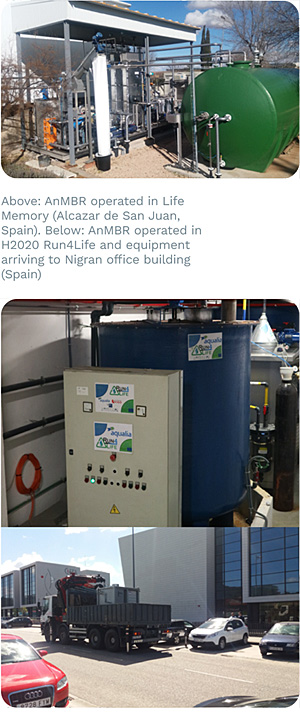 Domestic wastewater (WW)
contains thermal energy
in the form of organic
matter (close to 4 kWh/kg
Chemical Oxygen Demand (COD)
for 500 mg COD/l – or about
2 kWh/m3), but in conventional
WW treatment plants (WWTP) the
organic matter is oxidised with an
electricity consumption of at least
0.5 kWh/m3, and producing sludge.
In larger WWTP with capacities above
50,000 population equivalent (PE),
this biomass can be converted to
biogas in anaerobic digestion, but on
average only up to 50% of the energy
can be recovered by co-generation.
Domestic wastewater (WW)
contains thermal energy
in the form of organic
matter (close to 4 kWh/kg
Chemical Oxygen Demand (COD)
for 500 mg COD/l – or about
2 kWh/m3), but in conventional
WW treatment plants (WWTP) the
organic matter is oxidised with an
electricity consumption of at least
0.5 kWh/m3, and producing sludge.
In larger WWTP with capacities above
50,000 population equivalent (PE),
this biomass can be converted to
biogas in anaerobic digestion, but on
average only up to 50% of the energy
can be recovered by co-generation.
Other valuable resources in WW are
nutrients, essential ingredients for
plant growth in agriculture, as each
European produces yearly about
4.5 kg N, close to 1 kg P and 2 kg K.
However, centralised WWTP can only
recover a small fraction of diluted
nutrients by precipitating up to 50% of
the phosphorus in sidestreams, while
two thirds of the nitrogen is converted
to gas and lost to the atmosphere. In
the production of artificial fertilizer,
this nitrogen is gained back from the
atmosphere with an energy input of
10 to 15 kWh/kg.
One approach to increase recovery
rates and optimizing the energy
balance is by treating concentrated
streams in a decentralized concept,
before the waste is diluted by the
freshwater use of 150 l/PE/d. The
project H2020 Run4Life (Recovery
and Utilization of Nutrients 4 Low
Impact Fertiliser) demonstrates the
options of decentralized WWTP,
based on the source-separated
collection of greywater (from
showers, basins…), blackwater, from
toilets), and kitchen waste, with each
flow receiving optimal treatment for
resource recovery.
As part of Run4Life, blackwater from
an office building in Nigran, near
Vigo in Galicia, is treated with the
AnMBR process, combining Anaerobic
Digestion (AD) with membrane
filtration to separate biosolids and
clean water. As ultrafiltration with
pore sizes between 0.04-0.1 μm
retains solids, bacteria and even
some viruses, permeate is suitable
for reuse while providing nutrients for
agriculture (fertigation). This in turn
reduces CO2 emissions by recovering
organic matter and avoiding the need
of mineral fertilizer.
Blackwater treatment at room
temperature removes above 90% of
the organic matter, while biogas with
>75% of methane concentration is
obtained and biosolids production
is cut by half compared to
conventional WWTP. The higher
organic concentration of blackwater
allows for direct AD treatment,
and incorporating the organic
kitchen waste increases biogas
production and nutrient recovery,
while avoiding biowaste collection
and transport.
This concept will also be applied by
Aqualia in the new Life Zero WasteWater project, in collaboration with
the University of Valencia, to exploit
their joint patent (EP3225596).
AnMBR has been demonstrated at
different WWTPs, achieving low power
requirements (0.15 kWh per m3 of
treated water in Life Memory) whilst
producing a nutrient-rich, pathogenfree
permeate.
AnMBR has also been used to retrofit
of an old septic tank of a small village
(20 m3/d WW), as OPEX was 20% less
compared to conventional WWTP. A
larger AnMBR to treat domestic WW
from an industrial park (400 m3/d), to
generate bioenergy and reuse water
in the factories and green spaces
is under design as a sewer mining
concept in H2020 Rewaise.
The Run4Life project receives funding from the EU Horizon 2020 Research and Innovation programme, GA no 730285. This article reflects only Aqualia's view. The European Commission is not responsible for any use that may be made of the information it contains.